|
|
|
 |
|
| Hanwei The Chinese Pudao (SH2072) |
Points: 14
|
The Chinese Pudao, originally an infantry weapon, has been adopted into the martial arts and its use in the hands of a skilled practitioner is spectacular. This weapon is also known as a horse-cutter sword, since it was used to slice the legs out from under a horse during battle. Our Pudao (SH2072) is a weapon to be coveted by infantry of old and modern martial artists alike. The high-carbon tempered steel blade has an agressive distal taper to promote quickness and balance and a long tang for strength, while the oak staff is tightly wrapped in a traditional pattern to optimize handling and adds to the distinctive appearance, as do the dragon-head bronzed steel blade collar and bell tassel. This weapon combines the best attributes of the sword and staff.
Sold Out
|
|
|
|
|
|
 |
|
| Hsu Quandao (SH2212) |
Points: 18

|
Named for its originator, the great General Kwan Yu, The Quandao started life as a powerful military weapon weighing over 100 lbs., but has since evolved into a martial arts weapon weighing considerably less (ours is 6.6 lbs.). The un-edged high-carbon steel blade has a distal taper for balance and is engraved in a dragon motif with the traditional bell tassel attached to the hook. The wooden staff terminates in a quatrefoil pommel and the blood cup and guard have a distinctive antiqued finish. Lighter and better balanced than most Quandaos on the market, ours is ideal for the martial artist training with this formidable weapon. The stand for the Quandao (OH2290 available separatelly) is crafted in solid oak and displays the weapon beautifully in the vertical position.
Sold Out
|
|
|
|
|
|
 |
|
| Hanwei Butterfly Swords (SH2067) |
Points: 12

|
Butterfly Swords (aka 8-Cutting Swords) are believed to have been developed by Shaolin monks as a concealable defensive weapon, used to disable rather than kill, which was prohibited by the monk`s code of conduct. The use of butterfly swords has since been honed to a fine art by martial artists, particularly the Wing Chun & Hung Gar styles of Southern China, where precision and two-sword coordination are emphasized. Our Butterfly Swords Set (SH2067) by CAS/Hanwei is a high-quality set featuring high-carbon tempered steel sharp blades with traditional dragon scroll patterning, leather wrapped grips and steel guards decorated in a dragon motif. This same motif is repeated on the fittings of the double scabbard. A wall plaque is included for display of the swords.
Sold Out
|
|
|
|
|
|
 |
|
| Hanwei Butterfly Swords (Rattan) (SH2293) |
Points: 14

|
Butterfly Swords (or Eight-Cutting Swords) are believed to have been developed by Shaolin monks as a concealable defensive weapon, used to disable rather than kill, which was prohibited by the monk's code of conduct. The use of butterfly swords has since been honed to a fine art by martial artists, particularly the Wing Chun & Hung Gar styles of Southern China, where precision and two-sword coordination are emphasized. The CAS Hanwei Butterfly Swords Sets feature high-carbon tempered steel blades with traditional dragon engraving.
Sold Out
|
|
|
|
|
|
 |
|
| Hanwei Tang Jian (SH2349) |
Points: 25

|
Our Tang Sword is a Jian that exemplifies the artistry and symbolism in Chinese culture across many generations. The proportions and balance of the sword will appeal to the Taijiquan practitioner, while the unique fittings and decoration will establish its place in many collections. The lion-dog guard is fashioned after the shoulder guards of the Mingguang Armour, an important armour suit dating from the Tang dynasty, while the handle is wrapped in leather over ray skin in a traditional Chinese style for a superior grip. The diamond-section blade has both profile and distal tapers, making for a very quick sword, and is engraved with an ancient dragon pattern over most of its length,. The wooden scabbard is decorated in figured brass and is provided with a belt attachment. The throat of the scabbard fits snugly into the mouth of the lion-dog, an interesting and unique feature!
Sold Out
|
|
|
|
|
|
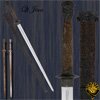 |
|
| Hanwei Qi Jian (SH2295) |
Points: 40
|
From the master swordsmiths of the Hanwei forge comes the Qi Jian, a re-creation of an ancient design that utilized one-piece forging. The entire sword, from pommel to tip, has been forged from a single billet of steel. This forging technique provides unparalleled strength and balance while exhibiting a clear, bell-like tone when lightly struck.
The sword's name originates with the Qi nation, one of the many warring states that eventually formed modern China. Legend has it that Feng-Xuan, one of the Qi people and a central character in a well known folk tale, possessed such a one piece sword and would use its ringing quality to accompany his singing.
The sword's grip is rayskin wrapped, a feature matched by the wrap on the throat of the scabbard, making for a stunningly beautiful presentation.
Sold Out
|
|
|
|
|
|
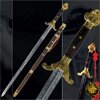 |
|
| Hanwei Qing Sword (SH2007) |
Points: 65
|
The traditional perception of the Taiji sword becomes very apparent in the Qing Sword. The last of the Chinese Dynasties, the Qing (Ching) Dynasty was overthrown by rebellion as late as 1911, by which time the Taiji sword had completed its evolution into the "modern" form. The sword is crafted around a beautifully pattern-welded K120C blade with a flattened diamond section. The guard and pommel are constructed of gilded steel featuring a flying bat design, which in Chinese ideology symbolizes luck. The scabbard decorations are in gilded brass and the intricate knot-work of the tassel is art in its own right.
Recreated by the craftsmen of CAS Hanwei from the swords of the Lords of the great dynasties, these Chinese Gongfu swords represent the pinnacle of the sword maker's art, vividly illustrating the skills and creativity of the smiths of Imperial China.
Sold Out
|
|
|
|
|
|
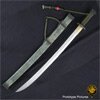 |
|
| Hanwei Beile Dao (SH2386) |
Points: 55
|
The original Beile (Lord in Manchu), also known as the "Banner Lords" and "Iron-Capped Princes" were the sons of Nurgaci, founder of the Qing Dynasty. After his death the Beile Hong Taiji was selected as Khan.
Our Beile Dao commemorates this Prince. Its beautifully detailed Iron furniture complements the patterning of the Damascus blade and the rayskin-covered scabbard adds to the rugged richness of the sword. Truly a collector piece and creating a demand in its homeland, this sword will only be available in limited quantities.
Sold Out
|
|
|
|
|
|
 |
|
| Hanwei Song Sword - Dynasty Series (SH2074) |
Points: 55

|
Our Song Sword sets the standard for functional production quality swords. This exquisite version by the craftsmen of CAS/Hanwei features a beautifully patterned folded K120C powder steel blade in a traditional willow-leaf design with deep fullers and top quality fittings. The solid bronze Full Moon guard has a flying goose motif on the grip side and traditional good fortune patterning on the blade side, repeated on the pommel and scabbard fittings. The grip is leather-wrapped over sharkskin, which also covers the scabbard. The beauty of this sword belies the fact that it is fully functional, with great inherent strength, balance, and cutting ability. GRIP: Sharkskin/Leather.
Sold Out
|
|
|
|
|
|
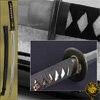 |
|
| Hanwei Practical XL Light Katana - 28,5 inch (SH6000LPF) |
Points: 18

|
The blade is forged and differentially tempered, using the same process as the more expensive blades and producing an HRC60 edge and HRC40 back. The temper line is authentic and prominent. Cost savings are effected by using fittings which, while making no claims to authenticity, are very strongly built to withstand the rigors of cutting exercises in the dojo.
Forged high-carbon steel blade
Differential tempering
Hanwei made
Sold Out
|
|
|
|
|
|
 |
|
| Hanwei Shinto Shinken Katana w Bohi (SH6004SGF) |
Points: 45
|
The Shinto Shinken Katana features a more traditional blade style than the other Performance Series models, specifically designed for a more frequent drawing practice, with a live sharp blade.
These live Iaito swords (Shinken) from Hanwei are made for the experienced Iaido practitioner who wishes to include light cutting (Tameshigiri) in his repertoire. The Shinken features optimized blade geometry, combining excellent balance with minimum weight for repetitive drawing, while retaining sufficient backbone for cutting light targets. The Shinto models have hand-forged high-carbon steel blades. Each blade is differentially hardened, to produce a distinctive hamon, and is grooved for balance and audible feedback in the cutting stroke.
Sold Out
|
|
|
|
|
|
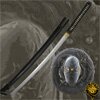 |
|
| Hanwei Shinto Elite Katana (SH6004KGE) |
Points: 45

|
The Shinto Elite (SH6004KGE) features a hand-forged T10 high-carbon steel katana blade featuring the geometry of the Performance Series. The blade is differentially hardened using the traditional claying method. The Shinto is mounted in black and the tsuka-ito is made of premium black Japanese cotton. The saya is finished in a deep black lacquer with a black cotton sageo. A finely rendered dragon, detailed in gold, with true front-and-back detail, forms the black iron tsuba. The fittings are superbly antiqued adding to the aesthetics of the set. The Shinto is supplied with a protective cloth bag and traditional maintenance kit.
Sold Out
|
|
|
|
|
|
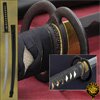 |
|
| Hanwei Musashi Elite Katana (SH6003KGG) |
Points: 30
|
Miyamoto Musashi, arguably the most famous swordmaster in Japanese history, fought more than 60 duels before retiring and writing his famous treatise on swordplay, the "Book of Five Rings". Development of the two-sword style of swordplay, with the Daito (long sword) and Wakizashi being used together, is credited to Musashi. Mounted in black, the Musashi Elite is faithful to the original down to the famous double-ring iron tsubas. The tsuka-ito is in leather over ray skin. The blades are hand-forged in high-carbon steel, with new geometry to enhance cutting ability. It is edge-tempered using the traditional clay tempering method, resulting in a distinct hamon. Edge hardness is HRC60, back hardness HRC40. The grip is double-pegged to the tang for safety. The cutting style katanas (Elite, XL, XL Light) include a traditional maintenance kit.
Sold Out
|
|
|
|
|
|
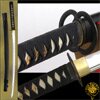 |
|
| Hanwei Musashi XL Light Katana (SH6003LGF) |
Points: 30
|
Miyamoto Musashi, arguably the most famous swordmaster in Japanese history, fought more than 60 duels before retiring and writing his famous treatise on swordplay, the "Book of Five Rings". Development of the two-sword style of swordplay, with the Daito (long sword) and Wakizashi being used together, is credited to Musashi. Mounted in black, the Musashi Elite is faithful to the original down to the famous double-ring iron tsubas. The tsuka-ito is in leather over ray skin. The blades are hand-forged in high-carbon steel, with new geometry to enhance cutting ability. It is edge-tempered using the traditional clay tempering method, resulting in a distinct hamon. Edge hardness is HRC60, back hardness HRC40. The grip is double-pegged to the tang for safety. The cutting style katanas (Elite, XL, XL Light) include a traditional maintenance kit.
Sold Out
|
|
|
|
|
|
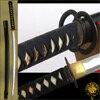 |
|
| Hanwei Musashi XL Katana (SH6003XGF) |
Points: 30
|
Miyamoto Musashi, arguably the most famous swordmaster in Japanese history, fought more than 60 duels before retiring and writing his famous treatise on swordplay, the "Book of Five Rings". Development of the two-sword style of swordplay, with the Daito (long sword) and Wakizashi being used together, is credited to Musashi. Mounted in black, the Musashi Elite is faithful to the original down to the famous double-ring iron tsubas. The tsuka-ito is in leather over ray skin. The blades are hand-forged in high-carbon steel, with new geometry to enhance cutting ability. It is edge-tempered using the traditional clay tempering method, resulting in a distinct hamon. Edge hardness is HRC60, back hardness HRC40. The grip is double-pegged to the tang for safety. The cutting style katanas (Elite, XL, XL Light) include a traditional maintenance kit.
Sold Out
|
|
|
|
|
|
|
|
Tags:
martial arts, katana, iaito, sword, fencing, tonfa, boken, bokken, kama, shinai, samuraj, judo, karate, kenjutsu, kenjitsu, ninja, kungfu,
|

















